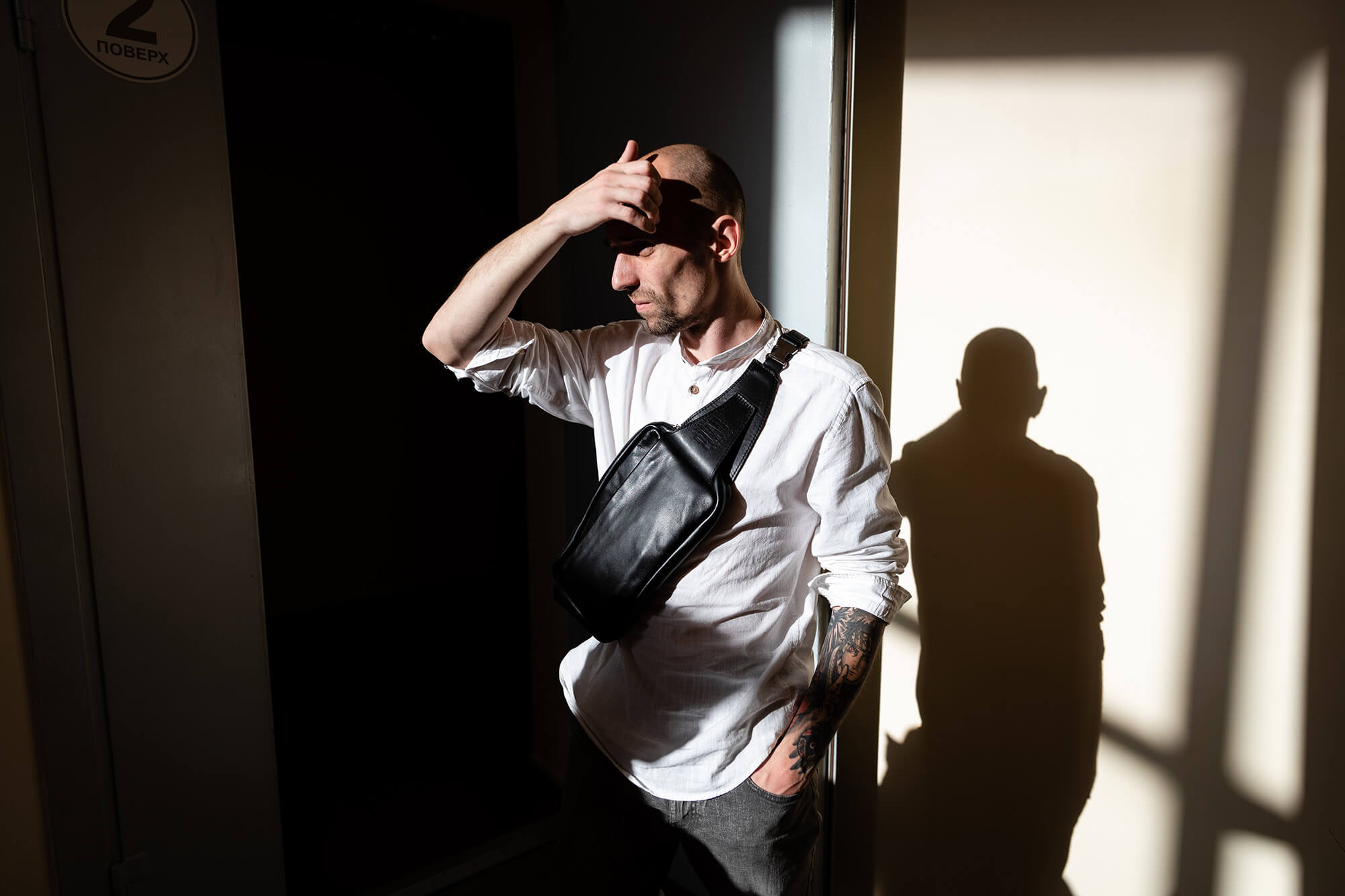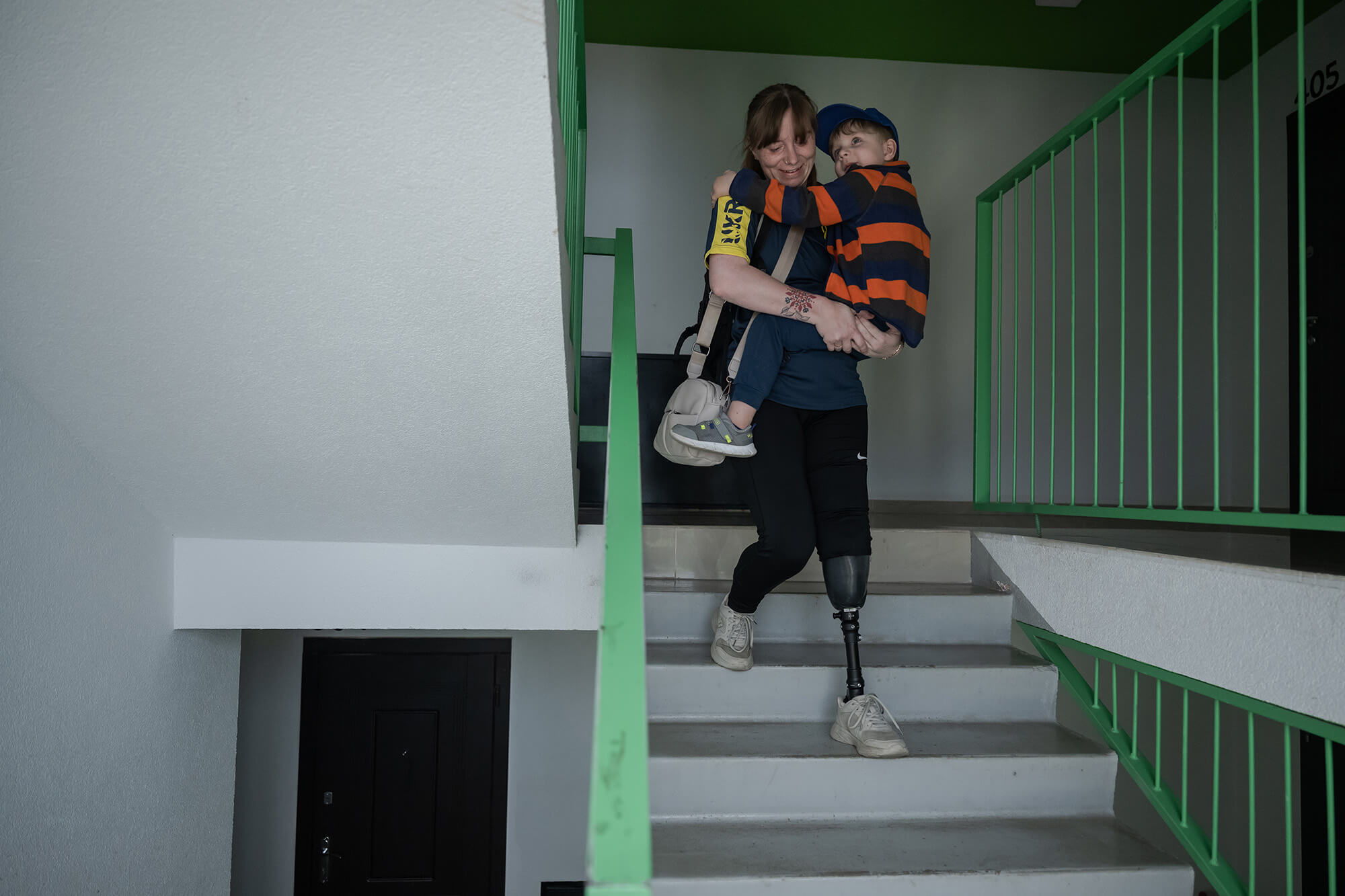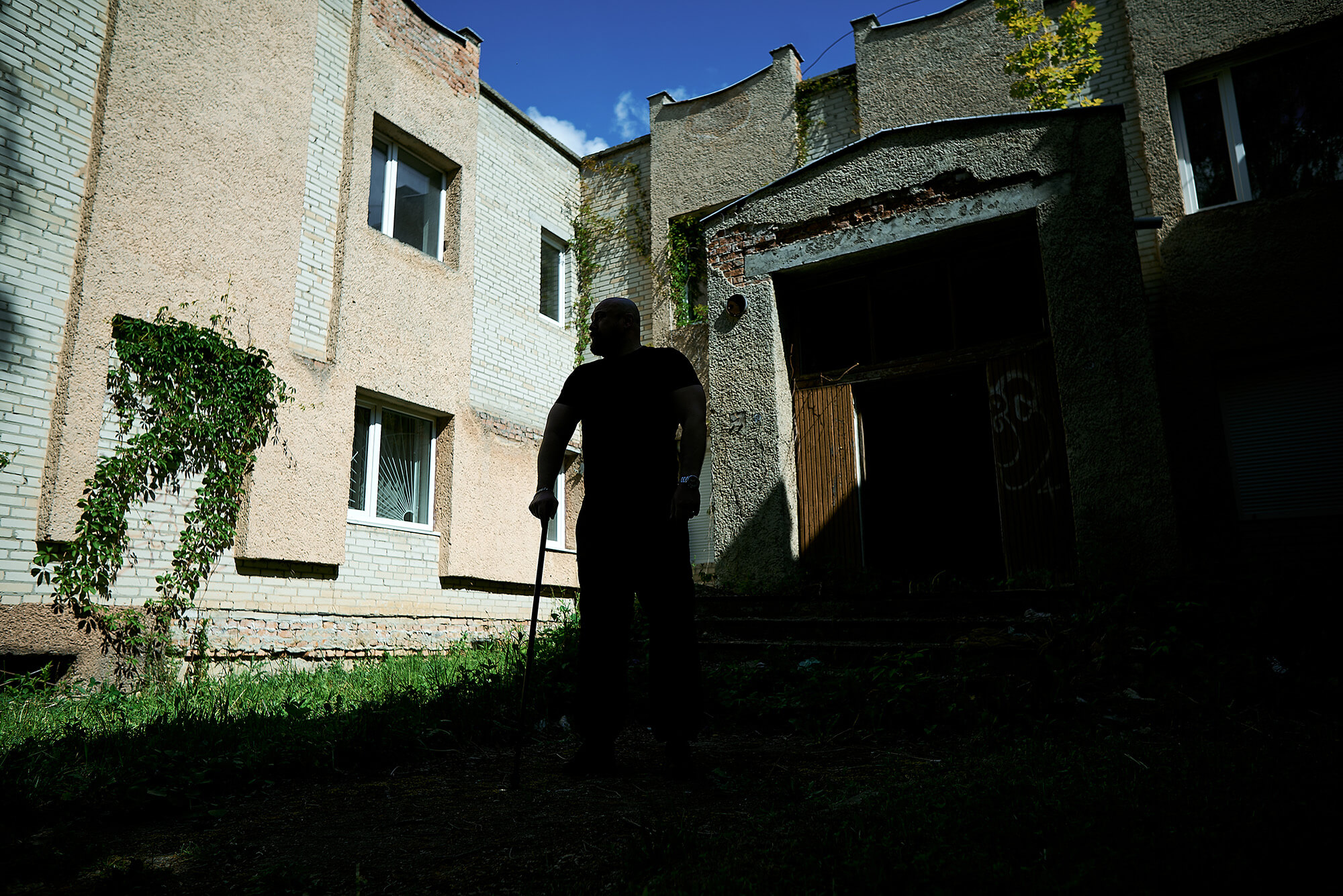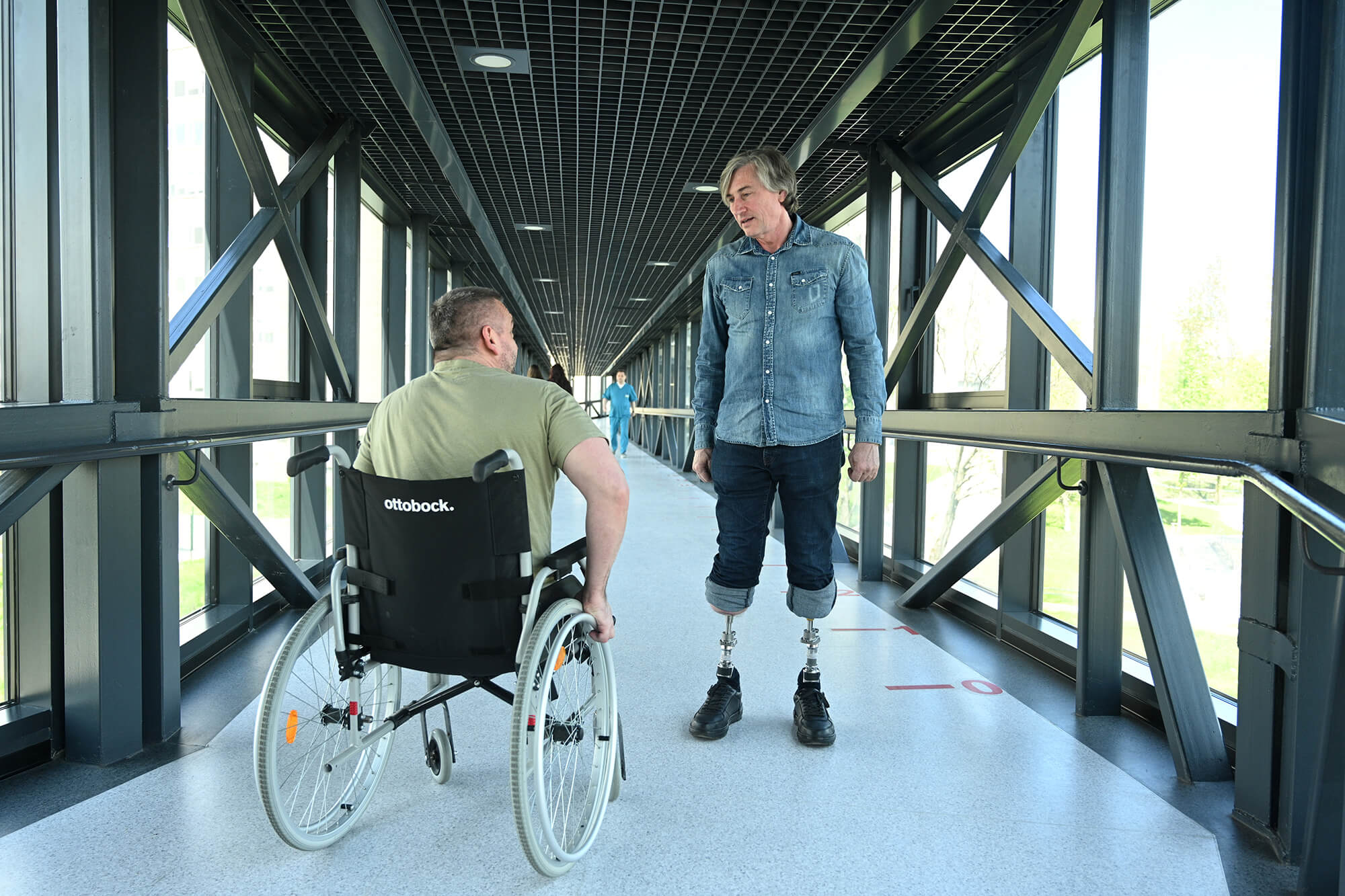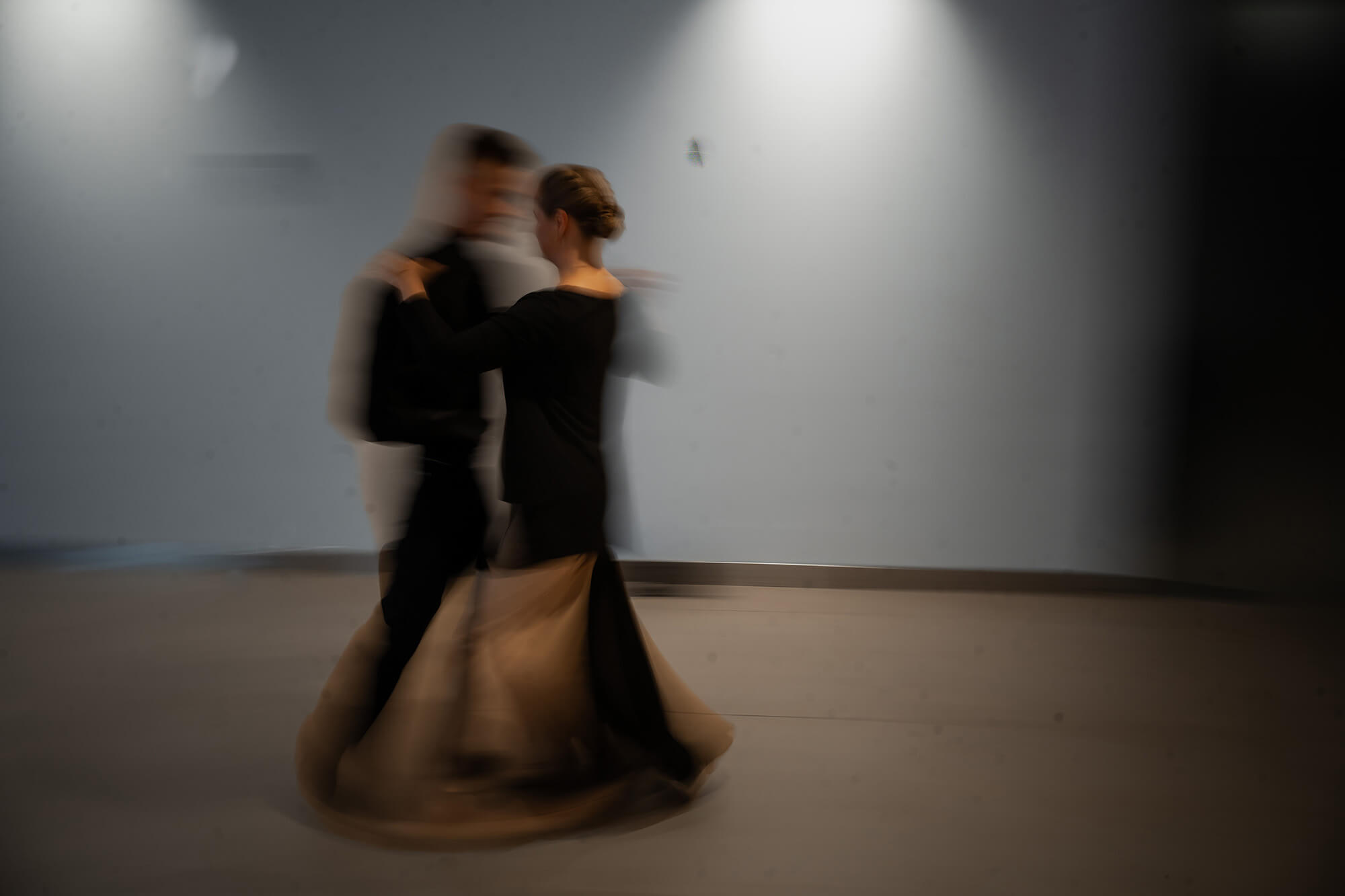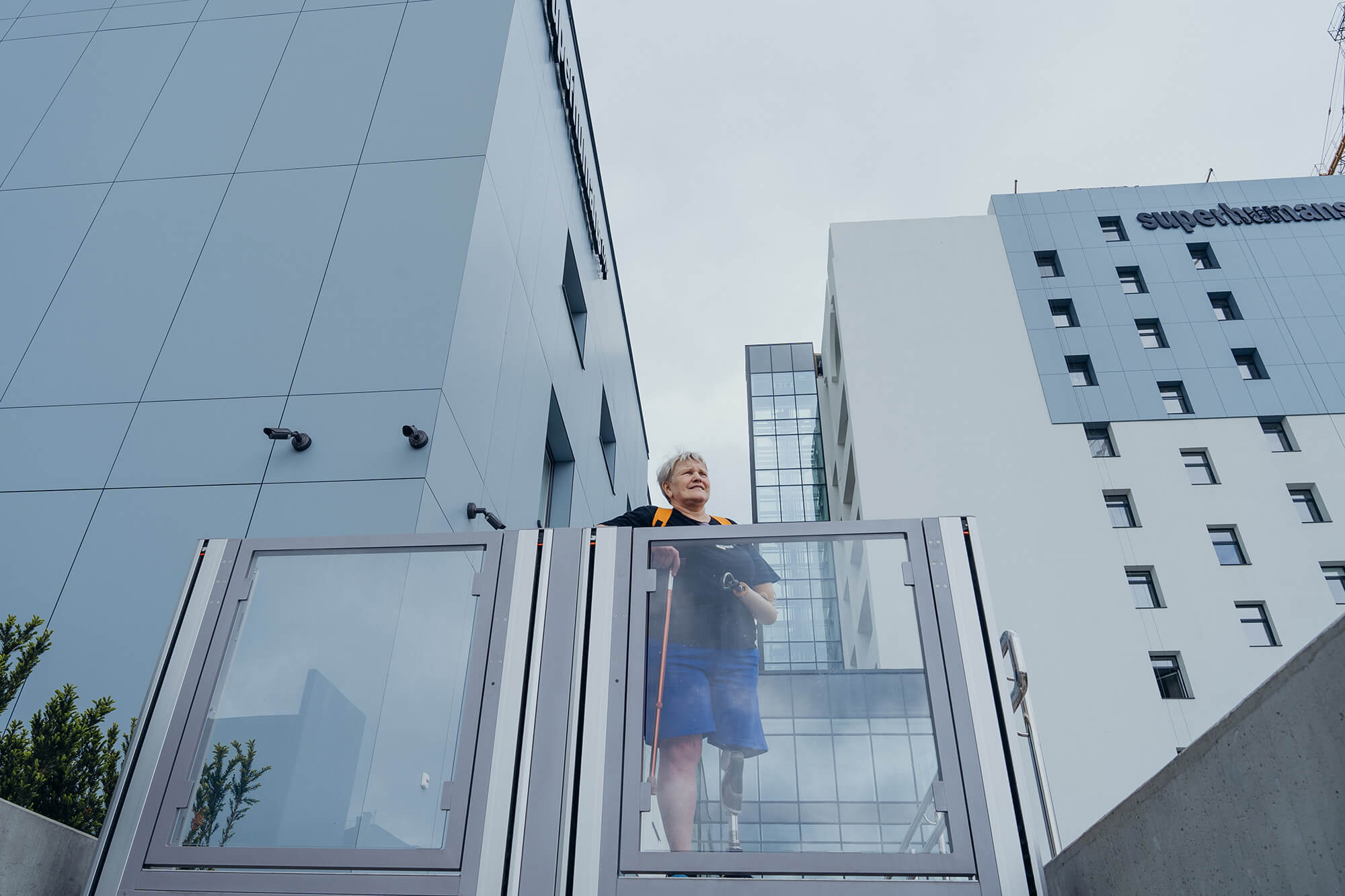
The Sea
[This story was published in the third printed issue of Reporters. Get your copy by joining The Ukrainians Community]
Three motorboats were slowly approaching his harbor. When the first began to moor, Kostia already had it in the crosshairs of his sniper rifle. He managed to get through to the guys from the Territorial Defense Forces who were located in the nearby summer cottages, but they had no idea if the mooring boats were friends or foes. The 40-year-old owner of a fishing base on the left bank of the Kyiv Sea had to defend his land on his own.
On the first day of the invasion, he counted 47 Russian helicopters flying low towards the capital. The enemy sought to bypass the reservoir on both sides, surround and occupy Kyiv. On the right bank, advancing from Belarus through the Chornobyl Exclusion Zone, the Russians almost reached the capital on the second day. On the left bank, they encountered resistance in Chernihiv, so could not hold the shoreline for too long—on March 6, our troops pushed them back almost to the border. It became relatively safe here, but Kostia knew that the horde had passed through the majority of the villages on the other side of the sea. Some of them were already occupied when he saw the boats.
What if it was a sabotage-reconnaissance group? He shoots well—he fires up to a thousand rounds a year, hunting ducks and, just for fun, cormorants, with which he shares the peninsula. Confident that he would hit the target, Kostia fired two shots 50 meters away from the engines of two nearest boats.
“Palianytsia!!! [meaning a type of Ukrainian hearth-baked bread, this word is used as an important shibboleth test, to identify people for whom the Ukrainian language is not native and phonetically familiar. During the 2022 Russian invasion of Ukraine, it was used to identify Russian soldiers or saboteurs because they could not pronounce it properly—R.] Palianytsia, damn it!” he heard from the farthest boat. “We are friendlies! Friendlies!”
Zamiokulkas
The left bank of the Kyiv Sea
The month of April, and we are on our way to meet Kostia. Last month, the Kyiv Sea fishermen—vacationers from the capital with their own boats and those who fish for profit—evacuated about 2,000 civilians from the occupied bank to the free one. The other way, they delivered tons of food, medicine and other essentials to the people surrounded by the enemy. Risking being shot or killed in a storm, some of them even bypassed the enemy upstream to deliver Ukrainian soldiers, weapons and ammunition to the rear of the Russians.
“Look, mines!” my fellow photographer Danylo says while keeping his hands on the steering wheel.
The closer we get to Kostia’s base, the more often we see landmine warning signs on the roadside. These are no typical red signs with a skull that we have gotten used to over the years of war—only small white signs nailed to pine sticks with the laconic “Mines” warning. This laconism does not frighten, it rather dispels the thick fog full of ghostly fears, engulfing with a calm clarity, a cold testimony of the reality of war and death.
We pass several small streets, which are not on the map, and come to a stop at the entrance to the fishing base. Kostiantyn Holovko came here for the first time almost 15 years ago. A small bay, cut off from the Kyiv Sea by a peninsula overgrown with forest, was quite neglected back then. There was a wooden pier that had been partially washed away by the water, and the bow of a sunken fishing vessel was protruding near the shore. But Kostia had a very different vision for the area.
“Come!” he says when he sees us. “I’ll show you around.”
Kostia has been fishing since he was young. Growing up in the capital, as a schoolboy he would occasionally help his father resell fish. Not local fish, but fish from the Kaniv Reservoir—another of the six large reservoirs of the Dnieper cascade, further downstream. His father’s business later ran into trouble and was no longer viable. Instead, the boy dared to start his own business. After working for a year after school as a longshoreman, he began to buy and sell freshly caught fish. Pike perch, crucian carp, catfish, bream—everything that could be found under the Kaniv steeps. His business went well, and a few years later Kostia had eight stalls in the capital’s outdoor markets. He then started supplying fish to large supermarket chains. Finally, he decided to start catching fish himself. It was more convenient to fish closer to Kyiv, so he explored the shores of the Kyiv Sea in search of a place where he could build a fishing base.
“I gave it a try, found out what to do and how, and leased four hectares of land for 49 years,” he says a little boastfully.
He does not hide the pride he feels in his business. Today, about three dozen people work for Kostia (in the best years, he says, he had around one hundred employees). During the season, they catch up to three tons of fish with nets every day. At least that’s what they used to do.
“People don’t like commercial fishermen like us. Private fishermen always accuse us of poaching. But we are honest workers! Everything is transparent and in the state databases—we have stocked this place with fish worth 1.3 million hryvnias over the last five years alone.”
Over time, a sturdy concrete pier was built in place of the old wooden one. There are several fishermen houses nearby—they are lived-in, but have never been fully completed and are in need of finishing. There are metal motor boats and a larger working boat on the water used as a net lifter. The peninsula behind the harbor, which locals and tourists now know as the Zamiokulkas by its official name, is furnished with gazebos and outdoor grills.
“When people come here with tents, I sometimes fry up some eight kilograms of pike perch and treat everyone to a meal,” says Kostia.
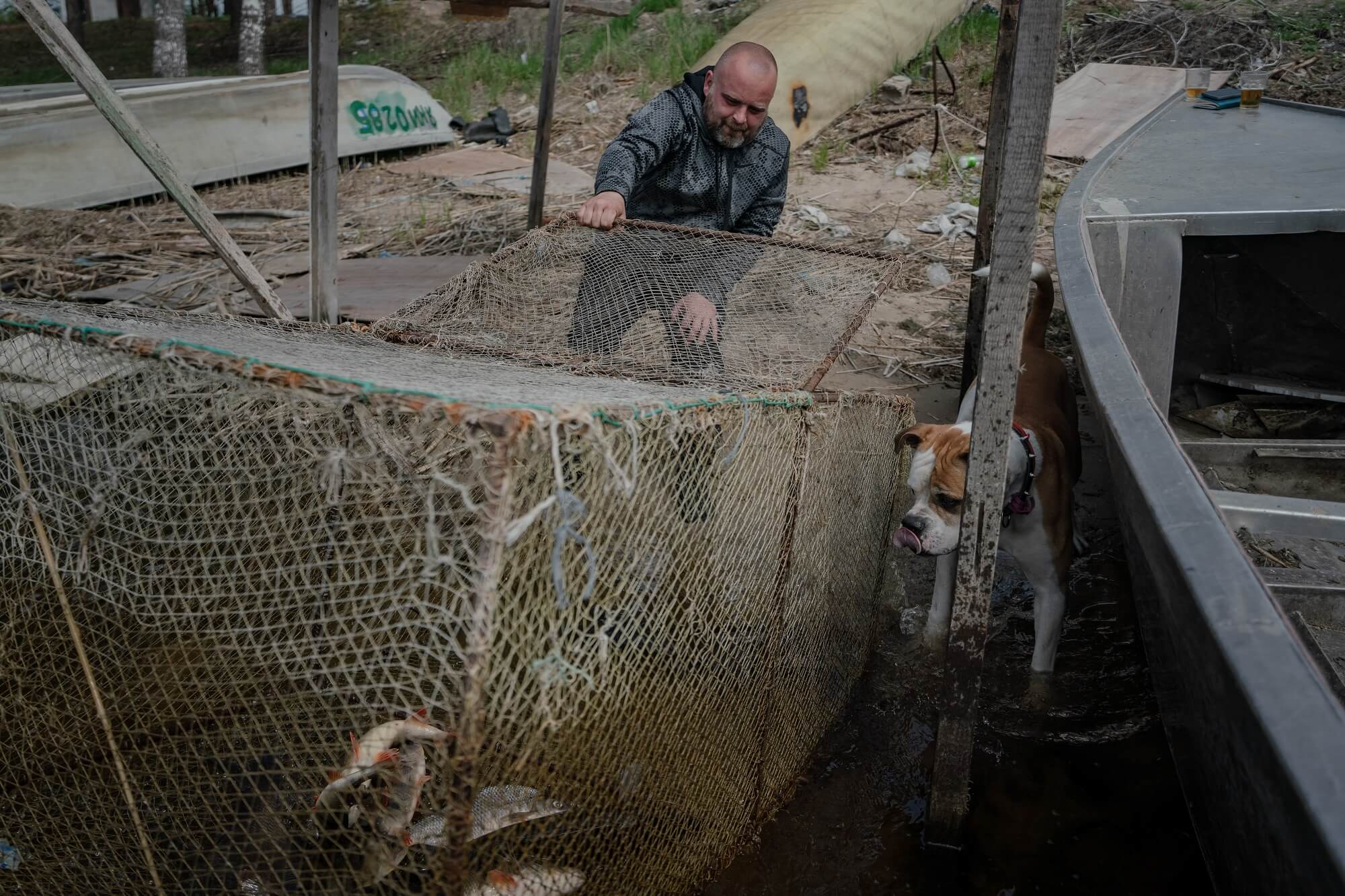
If I had never holidayed in the Zamiokulkas and was not aware of the local hospitality, it would have been difficult to believe it when looking at the owner. While talking, he fiddles with the blade of a small knife, and generally creates the impression of a person you wouldn’t want to mess with. He has a scar on his forehead, and served a suspended sentence for exceeding self-defense. He shot at a man with an air gun who, as he says, was trying to raid his camp. His dog Pol—a 10-year-old American bulldog named Policarp—is so like him. Yet, the dog, like his owner, is big but very kind—he constantly licks your hands and wants to play.
“When the war began, the sea was still covered with ice,” Kostia recalls. “I got a call from the other shore and they asked me to bring some stuff. It was for 11 women, all mums. Due to the stress, they had lost their breast milk, so there was nothing to feed the babies. They also needed diapers. So I told them right then that I would do what it takes. I asked my men to get the boats ready, and went to Kyiv to buy the essentials. At first, I bought everything myself, but later on volunteers joined the cause. When I was driving there the first time, there were explosions everywhere.
On the right bank in Kyiv, the blasts were so strong that they shook the car windows. I rolled them down, and thought, if I get hit, so be it!”
It was loud indeed. Russian planes were flying over both banks of the Dnieper right up to his area and firing missiles at the capital. Kostia saw them with his own eyes from the base. They could also be seen from the opposite occupied shore of the Kyiv Sea.
Obviously
Kyiv Reservoir
We get on the boat when the sun is diving behind the horizon. There are no seats in the aluminum boat—it is only designed to transport fish, not people. But it could accommodate around 15.
I crouch down carefully, holding on to the deep boat side. Kostia starts the engine, and it roars like a beast. The powerful engine accelerates the boat to 40 kilometers per hour. Kostia says that some of his boats can reach 80 kilometres per hour, but even 40 on the water is still fast. The wet wind slams against our faces and ruffles our hair, while the waves throw us up and down.
As we round the peninsula from where a flock of birds takes off, the vastness of the Kiev Reservoir opens up before us. It is called a sea for good reason, as it seems to be endless—there is water wherever you look, and the opposite shore is barely visible as a thin strip on the horizon. Today the sea is relatively calm, but it can be stormy for days and nights on end. Frequent storms turn it from the current greeny blue to an alarming grey, and the wind and waves become dangerous.
“In the time that I’ve spent here,” Kostia shouts over the roar of the engine and the wind, “more than a dozen people have drowned here. I remember how two fishermen went out into a storm—God knows why they couldn’t sit still in one place. They lacked the experience to cope with the force of nature and both of them drowned.”
After making a small circle, Kostia turns the boat around, and we head to the base. The sun is gone and dusk is falling over the water. I squat with my back against the boat, listening to the waves crashing against it and studying the geography of the shore.
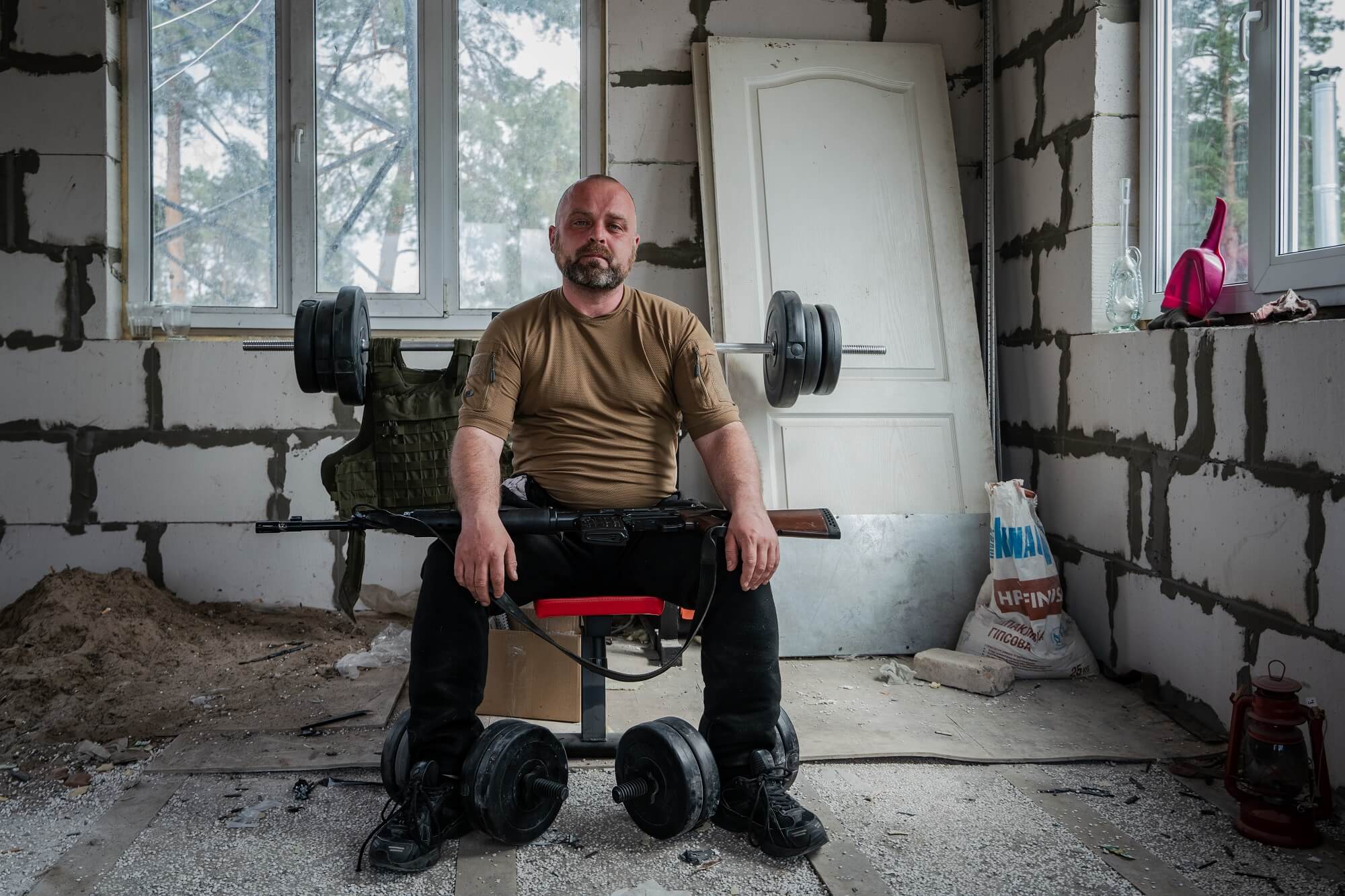
How did people feel fleeing the occupation?
Obviously, they must have been cold—there were still severe frosts in the first weeks of March. The cold temperatures on the water coupled with the wet wind would have been merciless.
Obviously, they must have been scared—in the first weeks of the war, fear paralyzed even those meeting or sitting out the war in the rear. And when a ferocious enemy comes right into your home and you are forced to flee across dangerous open waters accompanied by ground and air battles, wouldn’t you be afraid?
Did they feel joy when they finally saw the shore—not just the shore, but the embodiment of protection and rescue?
“We’ve arrived,” Kosta’s voice and the abrupt sound of the boat hitting the shore snap me out of my thoughts.
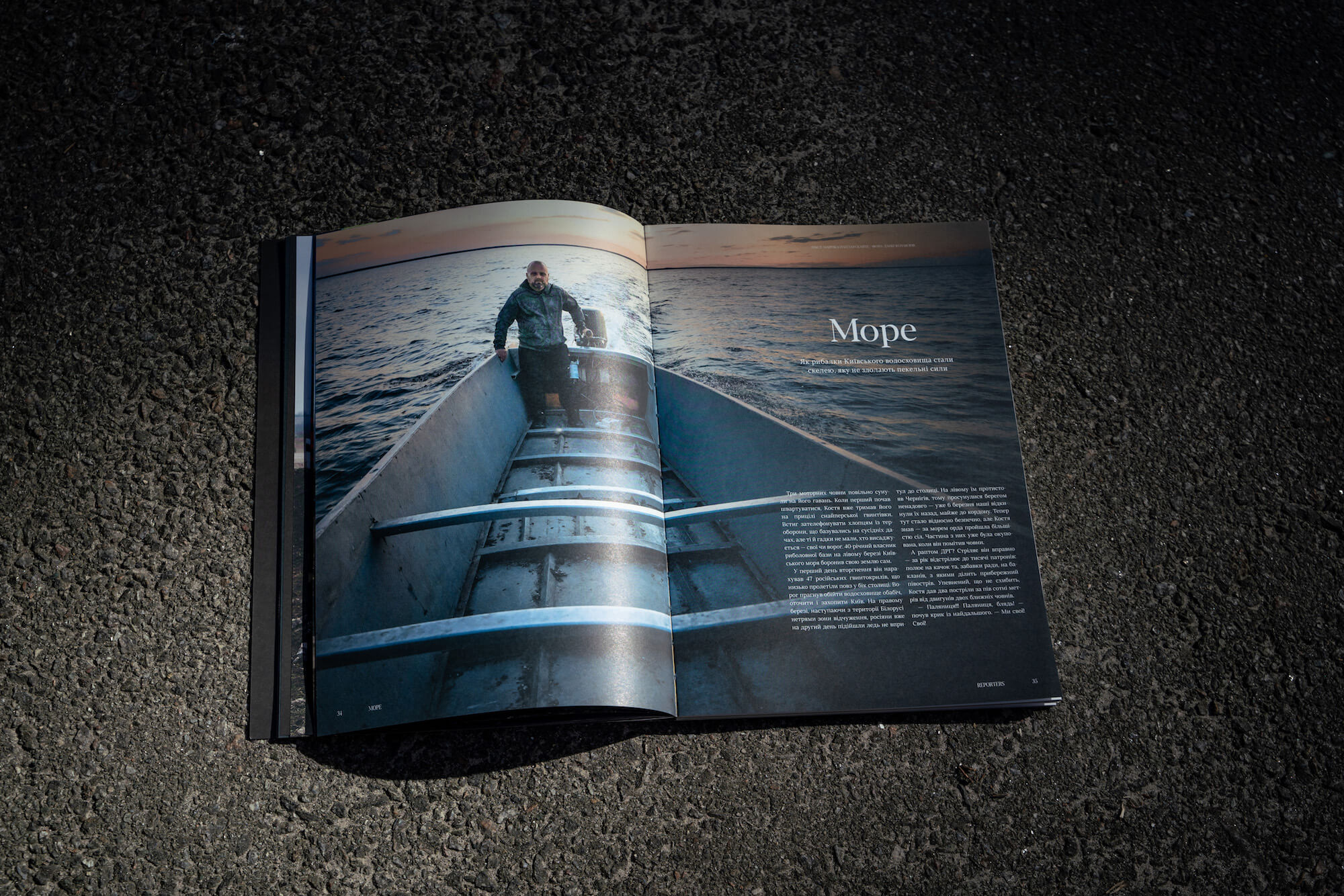
Join The Ukrainians Community to get your copy of the printed Reporters magazine twice a year
So as not to forget anyone
Strakholissia, the right bank
“Mum, are you sure they won’t shoot you? You will make it, won’t you? Are you sure they won’t kill you, mum? Tell me they won’t!” Tatiana’s nine-year-old son kept asking her. That night they said goodbye to each other, as if forever, and didn’t sleep a wink until dawn.
On March 12, at 9 am, good people met Tania Bilash at a pier in Strakholissia—a village located almost directly opposite Kostia’s camp, on the other side of the sea. They gave her a warm jacket which she put on top of the one she was wearing, helped her put on a life jacket, and wrapped her in a blanket. It was freezing at night, and it only got slightly warmer in the morning.
Tania was expecting the birth of her second son. She was due to give birth in less than a month, and she had already come to terms with the fact that she’d have to give birth at home. However, her husband and neighbors decided that she should flee the encircled village and reach Kyiv while there was still a chance.
She warned them that she was terribly afraid of water, and that she always gets seasick. Yet they still put her in the boat, facing the back, as it seemed safer that way. Tania could not see how the boat was repeatedly breaking into the ice with its bow, she only felt the sharp jerks and heard the crashing of the frozen water. She could hear the firing—back then, drones and planes kept flying over the village along the sea. With her eyes closed, Tania was silently saying the Lord’s prayer and thinking about her son’s questions. “Now we’ll definitely get hit. We’ll get hit for sure,” obsessive thoughts were interrupting her prayer.
But in the end, they made it to the other side unharmed. And an hour and a half later, the boat docked at the opposite shore. When she felt the ground under her feet, it was like she could walk all the way to Kyiv. It’s safe here. Our people are here.
It was the first trial boat rescue, so it was the riskiest of all. A few days later, among others, they rescued a seven-year-old girl Ania. When the war began, she was visiting her grandmother in Strakholissia, and now she was going back to her mother who was in the capital.
“You are one of ours,” Ania said to the soldier who was helping her out of the boat. “I recognized you by the blue and yellow chevron.”
And then she smiled and added:
“Glory to Ukraine!”
“Glory to the heroes!” the adult man in the uniform replied to the seven-year-old and turned away so that the kid would not see his tears.
Less than four weeks later, Tania gave birth to her second son in Kyiv maternity hospital No. 2. She is grateful to her fellow villagers for saving two lives. So as not to forget anyone, she carefully lists all the names, surnames, or village nicknames of those involved in the evacuations and coordinating volunteer help: Anatolii Melnyk, Andrii Bushuiev, Stanislav Zakusyla, Andrii Mudrachenko, Andrii Litovchenko, Aliona Aliieva, Aliona Anatoliivna (“secretary of our council”). And also Sasha Dvorianets (Kulyna), Vitia Melnyk (Maliok)… “I didn’t forget anyone?”
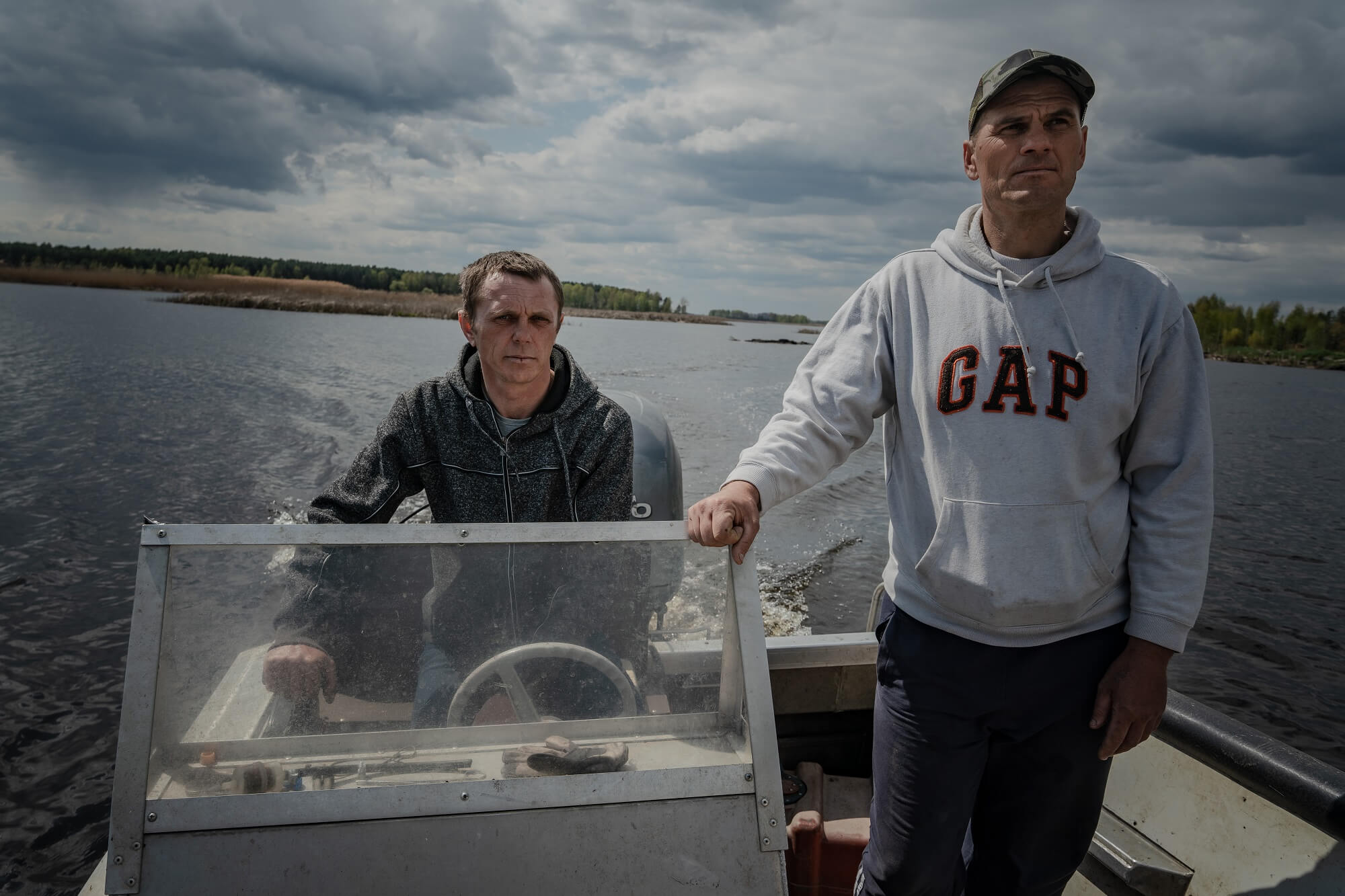

How can you say no to this?
Fish drop-off point, Strakholissia
“How was it?” one of the fishermen, Sasha, asks. In March, he and his partner made some thirty trips to evacuate people from one bank to the other. “What was it like? Simple but scary.”
In Strakholissia, he is rather known by the nickname Kulyna, which he inherited. This was the name of an elderly local woman, whose yard fence Sasha’s father accidentally drove a tractor into. The old woman made her displeasure known across the village. Since then, the culprit was named after her.
39-year-old Sasha Kulyna is a local resident. As he says, he was born here and will die here. Since his mother died when he was 11, he started going fishing in the sea with his older brother. He served his time in the army, worked in Chornobyl at a forestry, and built some vacation houses in and around Strakholissia. And then he got into commercial fishing. In the season that begins in June after the fish has spawned and lasts until the first ice, his normal day begins at dawn, around four or five am. Before the sun climbs higher, fish must be taken out.
“We know the local reedbeds really well, and can find our way round at night with our eyes closed,” says his colleague Vitia, known as Maliok.
Strakholissia, which is located 130 kilometers away from the capital, borders the exclusion zone—it takes less than 20 minutes by car to get to the Dytiatky checkpoint.
The surrounding area is a nature reserve. There are no jobs other than fishing or construction. That’s how the locals earn their living here.
No more than 400 people permanently live in the village. In summer, the population is boosted by about 100 vacationers. And when the war began, the population of the village increased to eight hundred. At first, vacationers from the capital fled here to wait the war out. Then people from the neighboring villages of Dytiatky, Orane, and Fruzynivka started moving here.
Driving here from Kyiv, we passed by recently occupied villages and towns. We saw the carcasses of bridges that had been blown-up to stop the enemy. We saw the insides of cottages hit by shells. We saw houses and fences dotted with bullet and shrapnel holes. But there was no such devastation in Strakholissia. This village, you might say, got lucky—it is located on a cape that juts out into the sea, and there was no gain for the Russians to enter it on their way to the capital.
“However, the noise was terrible here when their convoys passed by,” Kulyna recalls.
“And what were we supposed to do? There was nowhere to run, other than into the sea,” Maliok adds.
The sea seemed hopeless, but it became the savior.
“A boat like this,” Kulyna points to one of the fishing boats similar to the one we went out on with Kostia, “how many people would it fit, Vitia? 15 or 16?”
“Something like that.”
The men did not evacuate their families.
“My wife is 26 years old,” Kulyna says and smiles, “and my child is three and a half. I had an opportunity to put them in a boat and get them out of here. But they wanted to stay here with me.”
“Why didn’t you go all together?” I ask.
“Did we really have a choice?” both of them are surprised by the question. “Half of the people who could have helped declined to take part in the evacuations. There was no one else to do it, so we had to. When you arrive and there are 10-15 people standing there, there is no other choice. We even evacuated an infant who was all cuddled up to her mum in a blanket—how can you say no to this?”
Together
A household, Strakholissia
“We were under fire, with shots flying directly over our heads,” 50-year-old Alina Aliieva recalls. In March, the manager of another small fish base in Strakholissia evacuated the stranded on her own and arranged the delivery of food to the occupied bank. She doesn’t say much about the shelling—whatever happened, happened. Instead, she treats us to some freshly baked home-made bread. Her entire house smells of these three hot crusty loaves.
“The war taught me how to do it,” she explains, noticing my delight. “After mobile internet connection had disappeared, as well as bread from the three local stores, I started looking for a bread recipe in cookbooks. Other types of food also disappeared from the shelves—cereals, sugar, canned goods, everything.”
“We live in the village. Everyone had some vegetables from the garden in cellars, but no one had large stocks. There was some food at the stores for one more week, but then everything ran out. People had money, but there was nothing to buy with it.”
People were trying to survive the hunger, as well as the war, by staying together.
“Our men would catch fish and deliver it to their fellow villagers for free. They would bring their catch to our local store and give it all to the people,” says Aliona. In addition to baking bread, she now knows how to stockpile. She keeps eight packs of salt under the table, and as soon as she takes one out, she buys a new one to replace it.
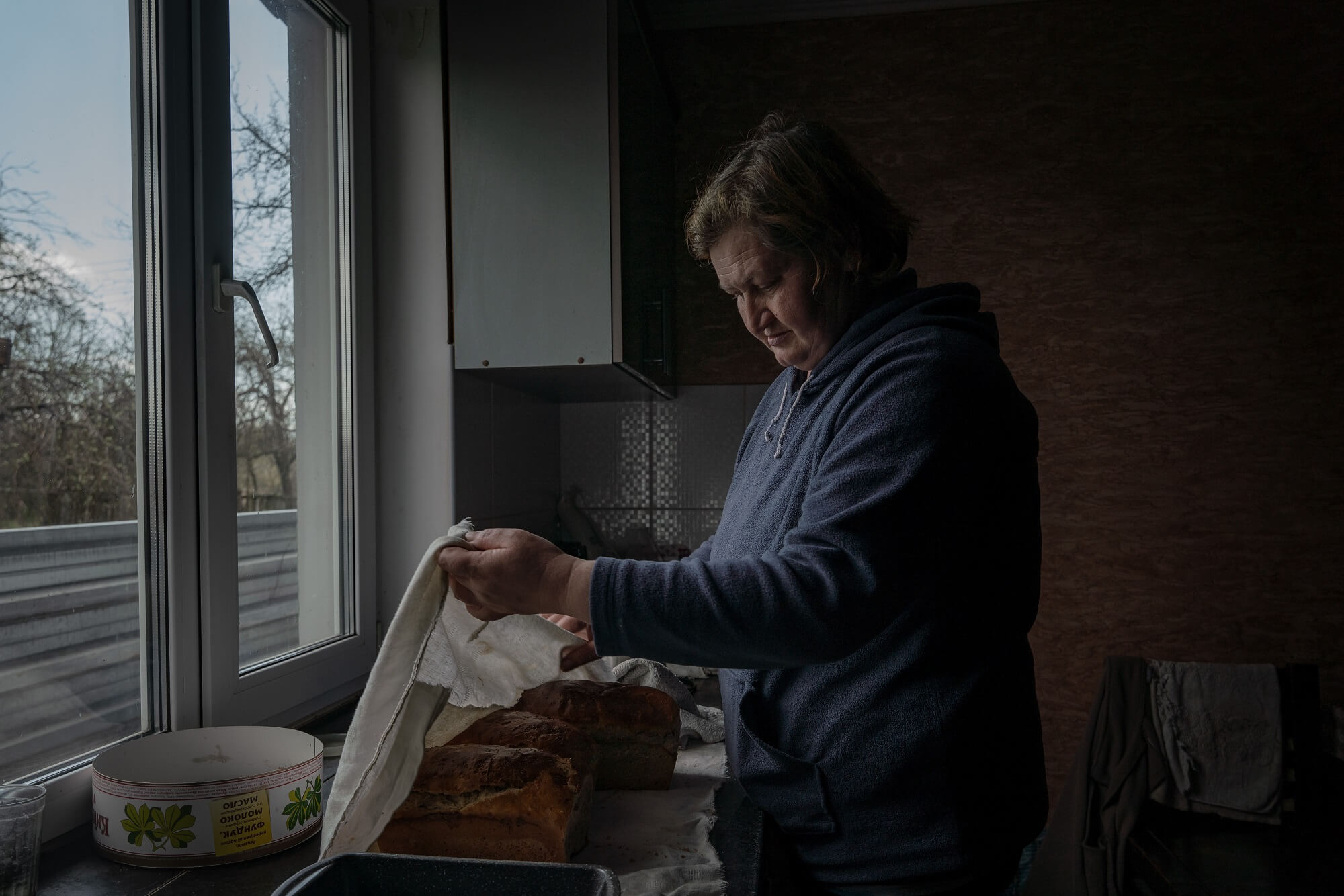
The unselfishness of the locals have become the stuff of legend, and everyone seeks to praise the other. Good things spread faster than bad ones. In addition to the donated fish, people also remember the piglets, which were slaughtered on a large farm in the neighboring Fruzynivka and also given to the people.
Food brought here by sea was collected by volunteers in Kyiv. They delivered large amounts of cereals, flour, yeast for baking bread, oil, canned goods, and sugar. The last time, right before the liberation of Kyiv Region, the Strakholissia fishermen had to cross the sea back and forth three times, exhausted from loading two tons of flour and half a ton of pasta. The food was distributed not only among the residents of Strakholissia, but also the neighboring villages controlled by the Russians.
“We took a risk, of course. Everyday we feared that the Russians would enter the village,” Aliona admits. They hardly spent a night at home. They were hiding at their relatives’ homes, since they heard that in the neighboring village of Bohdany any involved in the evacuations were taken with bags on their heads to Dymer and kept there in a basement. The residents of Strakholissia still don’t know how it ended.
Meanwhile, further downsteam and closer to the capital—in Borodianka, Irpin, Bucha, and other towns and villages—Russian soldiers were breaking into the homes of peaceful Ukrainians, robbing, raping and killing unarmed people. All because of hate. Fortunately, this news reached Strakholissia after the region had been liberated.
Roots
Zamiokulkas fishing base, the left bank
One day in March, at 5 am, the landing troops of the Carpathian Sich volunteer battalion took to the water from the left bank of the Kiev Sea, not far from Rovzhi. Ten fast boats owned by local fishermen and summer residents were to secretly ferry our military men to the right bank to the enemy’s rear near the Belarus-Ukraine border. All communications were prohibited even in case of damage to the boats. The military had the challenging mission to identify and destroy the Russian convoys in several areas between Orane and the former Zalissia near Chornobyl, without causing harm to the local residents. Mission Neptune was kept secret until it was complete.
The troops set off from Kostia’s pier on Zamiokulkas—during the battles for the Kyiv Region, the Ukrainian military were stationed on the peninsula. The owner of the fishing base, who had already enrolled in the Territorial Defense Forces Reserve, welcomed them as his guests. He says that there were about a hundred men: Carpathian Sich, and men from the Azov and Aidar units. The neighbors unnerved the owner’s bulldog Pol—the elderly dog has disliked weapons since she was a puppy. And two armored vehicles with anti-aircraft missile system launchers were stationed here for several days—part of the capital’s air defense system. Kostia realized that in response to the shooting, the Russians could destroy his base, but he did not argue with the military, “If it has to be done, it has to be done.”
The pier looked like an anthill. The military, civilians, weapons, humanitarian aid—all together.
“You asked if we needed help,” Kostia said when calling his friend, 55-year-old Yurii Sych, from a neighboring holiday village. “Then be ready in an hour.”
Yurii was ready. He loaded his own motorboat, which he uses to go fishing, onto the ATV trailer and quickly made his way to the base.

“There were so many of them here,” he remembers, spreading out his arms, “it was impossible to hug them all.”
“During the crossing, he will be your captain. Do what he says,” Kostia introduced him to the military. Yurii felt a little uneasy. He would have preferred to be among the volunteers—he wanted to fight back in 2014, but his wife and daughter didn’t let him go. Now, on the first day of the invasion, they also literally had to hold him back, when he pulled out his rifle aiming at a Russian helicopter overhead from his backyard with an indoor swimming pool and well-kept lawn.
“Are you insane?” his daughter exclaimed. “They will destroy our cottage and all the neighbors’!”
Upset with his relatives, Yura helped the military financially. He modestly says that he has a “With Ukraine In the Heart” volunteer medal for selfless service to the Motherland. Over the eight years, he has donated over UAH 200,000 to the army.
“There were several episodes when our troops suffered great losses, I was terribly sad and started talking about joining the army again,” the word “episode” gives him away as a former police officer, but that was a long time ago. In recent years, Yura has been running a business selling car batteries throughout Ukraine.
Now Kostia had given him a chance. The sea was stormy and the wind was freezing to the bone as they sped across the water. But Yura looked at the men in the boats—six in each—and felt so touched and happy to be there.
“They were much younger than me. My daughter is 32, and some of them were even younger. I looked at them and thought how they could be my son-in-law, my son! They were so young. But so brave.
To tell you the truth, there was no fear in their eyes.”
He made four trips across the water, 3 hours each there and back. Yura knew that he was taking them to a place where the men would be risking their lives. But it still came as a shock when, a day before our meeting, he heard the news that 14 fighters of the Carpathian Sich military unit, among those he had ferried across the water, had later died fighting for Ukraine.
“It’s very hard,” he sighs. “They sacrificed their lives for us.”
“But you also helped them in our joint battle,” I point out.
“How could I have not?” he says with passion, in which I hear rage, faith and love. “Tell me, how could I have not?”
High waters eroded the coastal zone along the entire Kyiv Sea. On the second day of the Russian invasion, the Armed Forces of Ukraine blew up the dam in Demydiv on the right bank. The Irpin, a tributary of the Dnieper, flooded. The flood created a natural barrier for armored vehicles and forced the enemy to move towards areas where ambushes awaited them. And excess water flowed into the sea.
In Zamiokulkas, the water washed away the ground beneath the roots of coastal trees. But now we can see, despite their nakedness and vulnerability, how tightly they clung to the Ukrainian land. How deep they grow. Like the people of this sea.
Have read to the end! What's next?
Next is a small request.
Building media in Ukraine is not an easy task. It requires special experience, knowledge and special resources. Literary reportage is also one of the most expensive genres of journalism. That's why we need your support.
We have no investors or "friendly politicians" - we’ve always been independent. The only dependence we would like to have is dependence on educated and caring readers. We invite you to support us on Patreon, so we could create more valuable things with your help.
Reports130
More